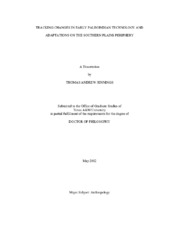| dc.description.abstract | This dissertation presents new data on early Paleoindian stone technologies in the Southern Plains periphery. Analyses of lithic artifact assemblages show that significant technological changes occurred between the transitions from pre-Clovis to Clovis and from Clovis to Folsom/Midland.
After an initial introduction to the problems in chapter one, a detailed technological description of the pre-Clovis assemblage from the Debra L. Friedkin site, Texas is presented. Site-scale and general technological comparisons to Clovis reveal similarities and differences. I conclude that the pre-Clovis assemblage at Friedkin cannot be considered Clovis, but could represent an ancestral technological assemblage. The third chapter presents the analysis of Clovis bifaces from the Hogeye site, Texas. I identify patterns in the biface reduction process and suggest that these patterns could be use to distinguish between regional Clovis cultural signatures and the idiosyncrasies of individual Clovis flintknappers. The fourth chapter compares Clovis and Folsom/Midland technologies and site-use at a single site, the Debra L. Friedkin site, Texas. I show that while late-stage biface reduction and point production were the focus of both occupations, Folsom/Midland groups also reduced some early- or middle- stage bifacial cores. More broadly, the Friedkin site shows that Clovis and Folsom/Midland settlement along Buttermilk Creek varied.
Ultimately, this dissertation provides new evidence of possible Clovis origins, documents Clovis biface reduction signatures, and identifies site-use and technological similarities and differences between Clovis and Folsom/Midland. Defining and comparing early Paleoindian adaptations and technologies is key to understanding how humans dispersed into North America and how they adapted to new and changing environments during the last Ice Age. | en |


